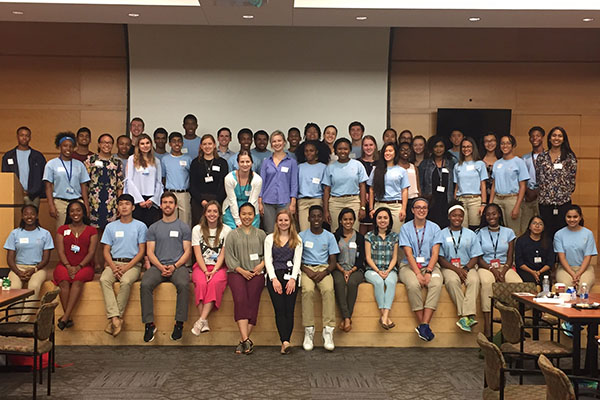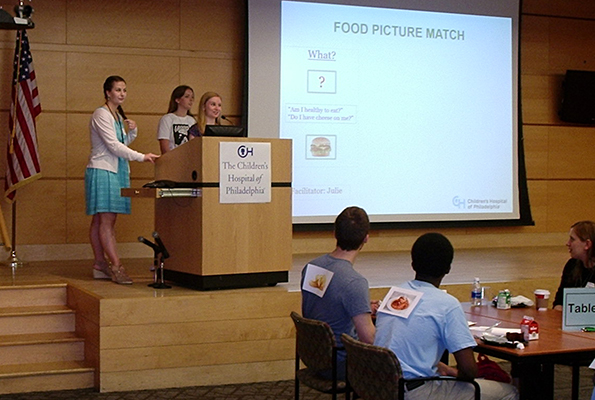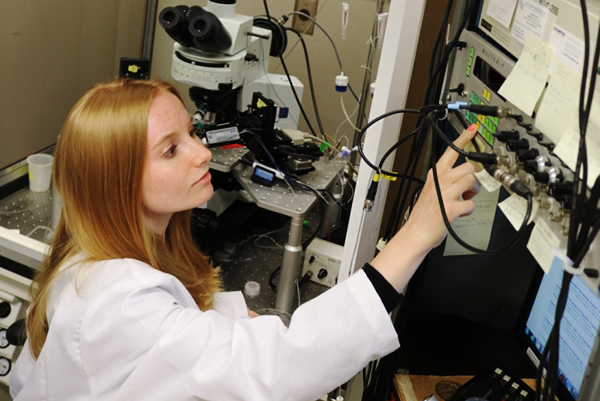HOW CAN WE HELP YOU? Call 1-800-TRY-CHOP
In This Section
A Day in the Life of a CRISSP Scholar
 Editor’s Note: The CHOP Research Institute Summer Scholars Program (CRISSP) hosts 25 bright, talented, hard-working undergrads from various universities to participate in a full-time mentored research experience on campus from June to August. The program is supported by a National Institutes of Health grant. This year, we invited CRISSP scholar Julie Uchitel to share some glimpses behind the scenes of a day in the life of a CRISSP student.
Editor’s Note: The CHOP Research Institute Summer Scholars Program (CRISSP) hosts 25 bright, talented, hard-working undergrads from various universities to participate in a full-time mentored research experience on campus from June to August. The program is supported by a National Institutes of Health grant. This year, we invited CRISSP scholar Julie Uchitel to share some glimpses behind the scenes of a day in the life of a CRISSP student.
My first few weeks with CRISSP have been great, and it’s happening so quickly that it almost feels unreal. My hometown in Southampton, Pa., is only a 45-minute train ride from our dorms at Penn, but it seems worlds away when I’m immersed in this program under the mentorship of pediatric neurologist Eric Marsh, MD, PhD. It’s pretty incredible that I have this opportunity before starting my third year at Duke University in Durham, N.C., where I study neuroscience and French.
I first became interested in neurology when I observed a grade school friend have a seizure. But it wasn’t until after I was chosen to participate in the division of Child Neurology’s annual Neurology High School Scholars Program at CHOP that I decided that I wanted to become a pediatric neurologist. I worked with pediatric neurologist Daniel Licht, MD, studying the feeding patterns of neonates with congenital heart defects. I learned about his research using optical spectroscopy, which uses near infrared light to measure cerebral blood flow and oxygenation in neonates. Similar to CRISSP, I also had the opportunity to shadow clinicians in CHOP’s main hospital.
Since I had already had on-the-job experience at CHOP, I looked first looked there for summer research opportunities and discovered CRISSP. I applied to work with Dr. Marsh, thinking it would be a good fit with my background in pediatric neurology and epilepsy research at Duke. What is most attractive to me about CRISSP is that, in addition to our independent research projects, we meet speakers who discuss professional development skills and present specific research topics. I’ve learned that as long as you care about your patients, you’re passionate about science, and you’re responsible with your research, your career path can take off in so many different directions.
Here’s a look at a day in my life as a CRISSP Scholar:
7:45 a.m. Morning After Shadowing the Emergency Room
Need coffee! Last night, I shadowed in the emergency room from 5 p.m. until around 11 p.m. CHOP’s ER has such a high volume of young patients that I was fortunate to see so many amazing cases unlike anywhere else. It was very busy — you’re thrown in situations, and you have to learn to adapt. But at the same time, the residents and attending physicians were very genuine. I could see how much they cared about the patients they were treating. One of the patients had a seizure for the first time, which was a case I was especially interested in. I really appreciate that CRISSP facilitates these clinical shadowing opportunities that otherwise might have been difficult for us to arrange on our own as summer students. I have also shadowed in general surgery with Pablo Laje, MD, and I’m looking forward to shadowing Dr. Marsh in a couple of weeks.
8 a.m. STEM-PREP Students Arrive for Breakfast

I’ve always been interested in science, so I enjoy meeting STEM-PREP students who share my love of science and medicine. STEM-PREP students are tenth-graders who are paired with CRISSP mentors to get to know the ropes of research and learn about the college application process. The high school students are from all over the country and placed in labs throughout Philadelphia, including CHOP and PENN, as part of a national program. This morning, I am serving as a group facilitator and helping coordinate some fun ice-breakers in a conference room at the Abramson Pediatric Research Center on CHOP’s campus. I also share some guidelines useful in mentor-mentee relationships, including approachability, availability, and positivity. My words of advice to the group: “Have faith in your mentor, and know that they want you to succeed.” As the breakfast wraps up, I hand out T-shirts with the slogan, “Discovery Starts With ME.” All this positive energy sure was a good way to wake up!
9 a.m. Finding a Perfect Solution
My next stop is Dr. Marsh’s lab on the fifth floor of the Abramson Pediatric Research Center, where my research day usually begins. I’m happy to see there’s still some apricot-pistachio biscotti left at our small coffee station tucked in a corner of the lab! This is my “home base” for my 10 weeks as a CRISSP student scholar.

“This is my ‘home base’ for my 10 weeks as a CRISSP student scholar.”
It was pretty tough at first learning all the small technical steps of my benchwork, but my research trainer has been great, and now I’m feeling confident enough to do most of my job independently. I start with making the solutions — combinations of sugar, salts, and highly purified water — that are needed at different stages of the experiments I’m conducting. The solutions allow me to record activity of live neurons in the very thin slices of hippocampus taken from brains of the mouse model that we study. After removing the brain and taking slices, the tiny brain slices will sit in a hot bath for about half an hour and then at room temperature for an hour before they’re ready for the next step of the process, which is recording the neurons’ activity.
12 p.m. Hungry for Knowledge
All the CRISSP students meet at weekly luncheons that give helpful presentations for launching our science careers. During one of our first lunches, we met with Dennis Durbin, MD, MSCE, assistant vice president and chief clinical research officer, about setting expectations and goals with our PI mentors. Today, we’re practicing our elevator pitches. The purpose of these pitches is to be prepared for when we’re asked to describe our research during an interview. A CRISSP faculty mentor is here to give us feedback and make sure that we’re presenting our research in a way that’s easy for others to understand.
12:20 p.m. Nailing my Elevator Pitch
OK, deep breath. It’s my turn to present my pitch. Here it goes:

“My words of advice to the group: ‘Have faith in your mentor, and know that they want you to succeed.’”
The Marsh Lab is focused on the ARX gene, which is a gene implicated in epileptic encephalopathies, a group of severe early-onset pediatric epilepsies. We study two mouse models of ARX, one that has a knock-out of the gene and one that has a specific polyalanine expansion mutation in the gene, to see how the phenotype manifests physiologically and on the cellular level. My specific project uses electrophysiology and voltage-sensitive dye imaging to identify changes in hippocampal activity of epileptic ARX mutant mice as compared to control mice. The hippocampus is important because ARX is expressed here in the brain, and hippocampal excitability is implicated in how seizures are triggered. The thought is that mutations or knock-outs of this gene will impair the way in which interneurons develop and lead to abnormal control mechanisms for excitability in the brain. Whew, that went pretty well! I was so impressed by everyone’s elevator pitches. It’s cool to hear about the CRISSP scholars’ wide range of interests, everything from basic, translational, clinical, to behavioral research.
1 p.m. Lights Out: Voltage-sensitive Dye Imaging
It’s lights out after lunch! I head upstairs to the voltage-sensitive dye imaging room on the eighth floor with my hippocampal slices. This room needs to be kept dark to prevent light interference with the voltage sensitive dye, so I bring a headband with a special red light that won’t interfere with the images that I’ll be creating. I load the slices with voltage-sensitive dye onto a stage with a recording electrode and a stimulating electrode. I send a current of electricity through the stimulating electrode to stimulate the tissue’s underlying neurons, which is associated with changes in voltage. The dye responds to these voltage changes, and a special camera that uses a florescent light records the changes in the dye. This camera takes a bunch of these images during stimulation and then creates a 3D movie that allows us to trace the neural activity within the hippocampal slices.
3:30 p.m. Toolbox for Data Analysis

“It was pretty tough at first learning all the small technical steps of my benchwork …”
I head back to Dr. Marsh’s lab to download the imaging data for analysis in Matlab, a software environment for numerical computation and visualization. In a previous study, the Marsh Lab developed a voltage-sensitive dye imaging toolbox that allows us to visualize and statistically compare differences in activity across space and time using the data from the hippocampal slices. The software geometrically converts the 3D movie to a rasterized 2D color map so that we can compare the experimental and control groups using Matlab. This computer processing can take a while, so I’ll let the program run overnight. I have Neurology Grand Rounds first thing tomorrow morning, and then I’ll get started on coding and interpreting the data for analysis.
5:00 p.m. Friends and Future Leaders
It’s been a busy day, and I loved every minute! I head back to our dorms on Penn’s campus to grab dinner with my fellow CRISSP scholars. I’m sure we’ll stay in touch long after the summer program ends. In August, I’ll be presenting an abstract at the International Epilepsy Congress being held in Barcelona, Spain, about research I’ve completed at Duke focused on epilepsy and alternating hemiplegia of childhood. From there, I’ll travel to Paris, France for the fall semester to study literature, history, and philosophy. I can’t wait to send my CRISSP friends photos from abroad. Maybe one day we’ll end up as colleagues collaborating on a project when I’m running my own neurology research lab!